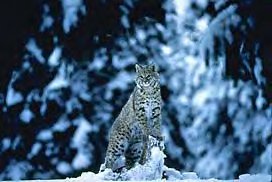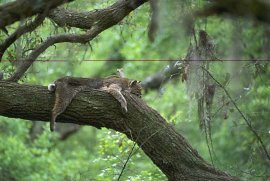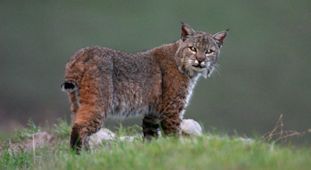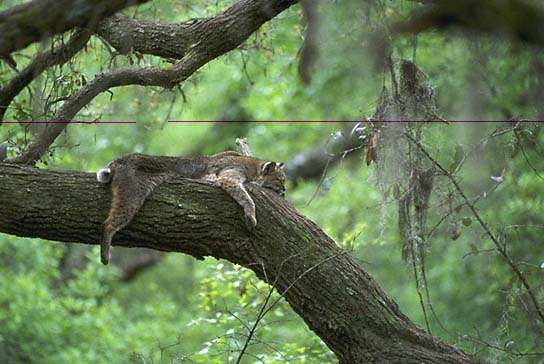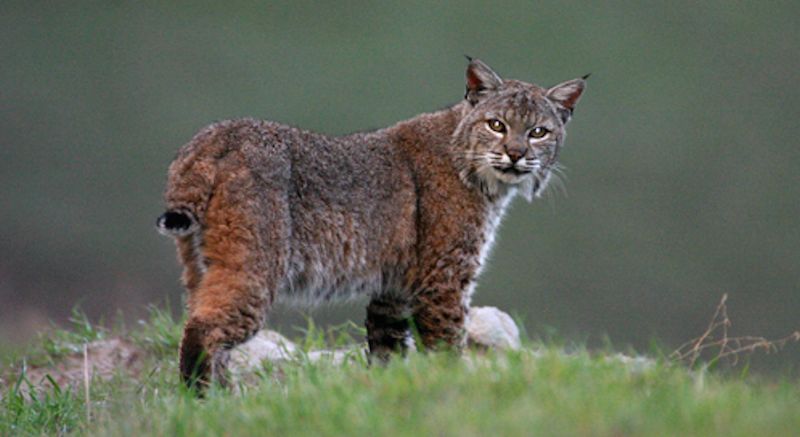Cats
Description
Tawny (grayer in winter), with indistinct dark spotting. Short, stubby tail, with 2 or 3 black bars and black tip above; pale or white below. Upper legs have dark or black horizontal bars. Face has thin, often broken black lines radiating onto broad cheek ruff. Ears slightly tufted. Male larger than female. L 28–49" (71–125 cm); T 4–7" (10–17 cm); HF 5 1/8–8 3/4" (13–22 cm); Wt 14–29 lb (6.4–13 kg).
Sign
Scent posts, established by urinating,
visible only on snow and identifiable only by tracks. Tree trunks
used as scratching posts, with low claw marks. Food cache usually
covered somewhat haphazardly and scantily with ground
litter.
Scat: Similar to a domestic dog’s. Often buried, but
sometimes merely covered with dirt scraped about and accompanied by
scratch marks on ground.
Tracks: Foreprints and hindprints about
same size, 2" (50 mm) long, slightly longer than wide, with 4 toes,
no claw marks. If clearly outlined, heel pad can be distinguished
from canine print: domestic dog’s or Coyote’s is lobed only at rear;
Bobcat’s is lobed at rear and concave at front, giving print
scalloped front and rear edges. Trail very narrow, sometimes as if
made by a 2-legged animal, because hindprints are set on, close to,
or overlapping foreprints; 9–13" (228–330 mm) between prints. This
manner of walking may be an adaptation to stalking: Hunting as it
travels, the cat looks for spots to place its forefeet noiselessly,
then brings down its hindfeet on the same spots.
Habitat
Primarily scrubby country or broken forests—hardwood, coniferous, or mixed; also swamps, farmland, and rocky or brushy arid lands.
Discussion
Found only in North America, where it is the most common wildcat, the Bobcat gets its common name from its stubby, or "bobbed," tail. The animal spends less time in trees than the Lynx, resting by day in a rock cleft, thicket, or other hiding place, but is also an expert climber. Sometimes it rests on a boulder or a low tree branch, its mottled fur providing excellent camouflage; if hard-pressed, it will swim. The Bobcat’s home range varies in size with sex, season, and prey distribution and abundance. It marks its range using urine (in large or small amounts that it may cover up), feces (also sometimes covered up), anal gland scent, and scrapes and scratches. It uses the same hunting pathways repeatedly to prey mostly on the Snowshoe Hare (in the northern U.S.) and cottontails (in the eastern U.S.), but also on mice, squirrels, Woodchucks, Virginia Opossums, moles, shrews, Common Raccoons, foxes, domestic cats, birds, reptiles, Common Porcupines, and even skunks. The Bobcat, like many larger predators, can fast for some time when food is not available, but eats heavily when it is. The animal consumes small prey immediately, but caches and revisits larger kills. The Bobcat and the Lynx are capable of killing prey as large as deer, but they seldom do so except in deep snow, when food is scarce, or when fawns are available. The Bobcat hunts small prey by waiting for victims motionlessly and then pouncing; pursues medium-size animals from a hunting bed or lookout, attacking by stalking and then rushing, or by simply rushing; and seeks large prey such as deer when they are bedded down. After a rush, the Bobcat will bite at the throat, base of skull, and chest. Occasionally the species preys upon livestock, especially poultry. When food is scarce the Bobcat will eat carrion, usually animals killed by cars or by hunters. This wildcat has a natal or maternal den and other auxiliary or shelter dens in less-visited portions of its home range. The natal den, with a nest of leaves or other dry vegetation, is often in a cave or rock shelter, if available, but can be in a hollow log, under a fallen tree, or in another protected place. Brush piles, rock ledges, stumps, hollow logs, or similar protected places serve as auxiliary dens.Like the Lynx, the Bobcat is a solitary animal, the sexes coming together only for mating. The Bobcat generally does not mate until its second year. Males are sexually active all year, but most females are in heat in February or March. More than one male may be attracted to a female; the female and dominant male may mate several times after a series of chases and "ambushes." The other males remain apart during matings, but the female may mate with them later. The young are well furred and spotted at birth. They begin exploring at one month and are weaned at two. By fall they are hunting on their own, but remain with the mother for nearly a year. The various calls of the Bobcat sound much like those of the domestic cat, although its scream is piercing. When threatened, the animal utters a short, sudden, and resonant "cough-bark." It yowls loudest and most often during the breeding season. Humans (who hunt Bobcats with hounds in some areas) and the automobile are this animal’s worst enemies, but predators such as foxes, owls, and adult male Bobcats may attack the young. Populations are stable in many northern states and are reviving in other states where intensive trapping formerly decimated the species. In some states, such as New Jersey, the Bobcat is being reestablished.

